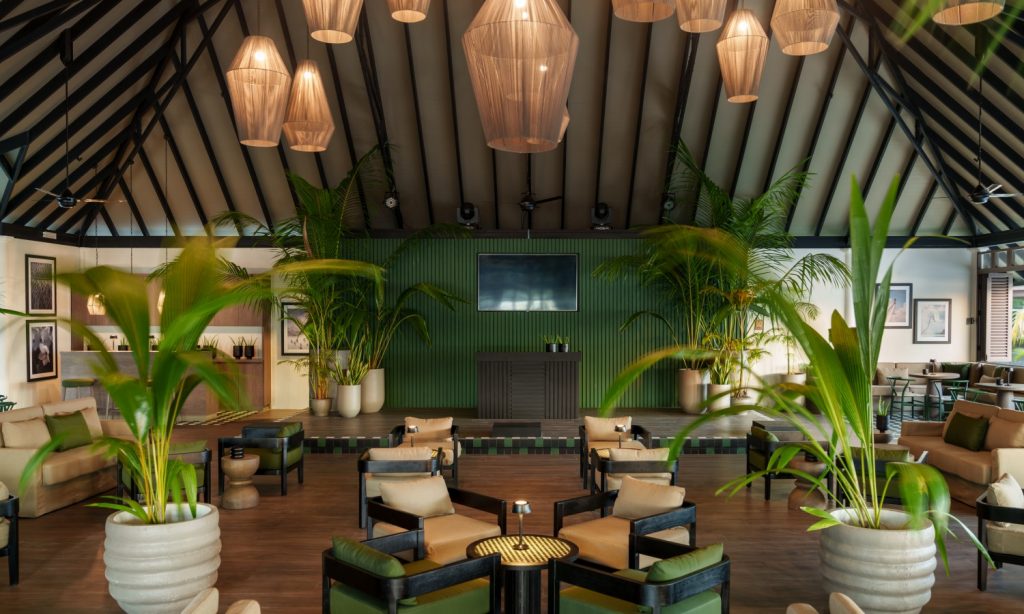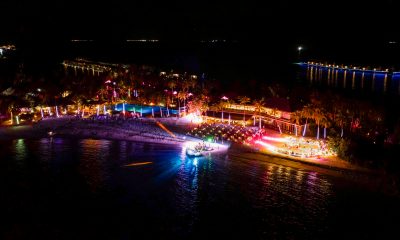Featured
Maldives central bank posts strong growth forecast for ‘resilient’ tourism industry

Maldives central bank has posted a strong growth forecast for the country’s tourism industry as it hailed the resilience of the industry observed last year.
In its annual report for 2016 released Tuesday, Maldives Monetary Authority (MMA) said the strong growth observed in the tourism sector during the latter part of last year is expected to continue this year. The strong growth is attributed mainly to the increased number of tourists from the European market, which reflects better growth prospects for the region, it added.
Mirroring the positive outlook for the sector, MMA projected bed nights growth to be at five percent in 2017.
“These projections may be even higher if the remarkable performance seen in the tourism sector at the turn of the year continues,” the report read.
Recovery in second half of 2016
Maldives marked 2016 as ‘Visit Maldives Year’ in an effort to reach a target of 1.5 million tourists entering the country during the year. Several tourism promotion activities were carried out in Asia and Europe, and many competitions and events were also held within the Maldives to boost tourist arrivals. While the campaign was successful in attracting 1.3 million tourists — four percent more than the previous year — it fell short of reaching the 1.5 million target.
According to MMA, the trend in tourist arrivals to the Maldives during 2016 showed that arrivals picked up strongly in the second half of the year. This increase was underpinned by improving economic conditions in European countries, coupled with a rise in flight movements by international carriers over the period, the authority said adding that the strong growth in arrivals from the European markets more than offset the decline in arrivals from the Chinese market.

MMA noted that other key indicators such as bed nights growth also followed a similar trend, gaining momentum towards the latter part of the year and recording an overall growth of three percent for the year. Reflecting this, the average duration of stay, which has been on a downward trend, fell only slightly to 5.6 days in 2016 from 5.7 days in 2015, contributing to a six percent growth in estimated tourism receipts, it said.
The tourism sector witnessed a major expansion in terms of the number of resorts and bed capacity in 2016, the authority stressed. With the opening of 11 new resorts, the total number of resorts in the country increased to 126 at the end of the year, while the number of registered guesthouses, hotels and safari vessels reached 382, 16 and 144, respectively. With regard to bed capacity, the average operational bed capacity of the industry7 stood at 29,457 beds.
Tourist demographics: Europe regains market share
As for the market share of tourists, Europe accounted for 45 percent of total tourist arrivals, while Asia accounted for 46 percent. Reflecting the improving economic conditions in the European markets, market share for Europe increased; this was a reversal of the downward trend of previous years. However, the market share of Asia — the market leader since 2014 — dipped from the 49 percent in 2015 to 46 percent in 2016.
Arrivals from the European market grew significantly at seven percent during 2016 after recording a marginal growth rate of one percent in 2015. This was mainly supported by growth in arrivals from the UK, despite a marked depreciation in the pound sterling. On the other hand, Germany, the second largest market from the region registered a marginal growth owing to political tensions in their country. Other key markets such as Italy registered a remarkable positive growth, whereas growth in tourists from France dropped significantly during the year. Arrivals from Spain also registered a sizeable growth compared with previous years. In addition, arrivals from smaller source markets in Eastern, Central and East Mediterranean Europe also improved.
“This can be attributed to an increase in flight movements to these regions during the year,” the report read.

MMA noted that arrivals from Russia — the fourth largest European market — also showed a strong positive growth after recording two consecutive years of negative growth. This reflected the easing of the recent economic recession that was prevalent in the country, it said.
Total arrivals from the Asia and Pacific region registered a marginal decline in 2016 after posting a positive growth during the previous year. Growth was largely hampered by the 10 percent decline in Chinese arrivals.
However, other key markets from the Asian region — such as India, Sri Lanka and Malaysia — showed pronounced growth on the back of increased flight movements. Some operators introduced flights to new destinations in 2016, including new flights to New Delhi and Colombo, contributing to more arrivals from both India and Sri Lanka.
MMA attributed the increase in arrivals from Malaysia to the growth in flight movements of a regional low-cost carrier from South East Asia during the year.
Arrivals from the Middle East also posted a strong growth rate, owing to an increase in arrivals from Saudi Arabia. This may be due to a new the commencement of Saudi Arabia’s flagship carrier Saudia between Riyadh and the Maldives, according to MMA.
Arrivals from the Americas, which have doubled in the past five years, also increased due to considerable growth in arrivals from the US.
Similar trends in 2017?
Despite the strong growth forecast by the central bank, Maldives has experienced another slowdown in tourist arrivals in the first quarter of the year. January saw a significant increase in arrivals, but growth has slowed down since then with a 2.1 percent drop in arrivals in March.
Europe, the largest regional source market which has been recovering for the past couple of months after a year of falling growth, also posted a drop of three percent in March with important European markets such as the United Kingdom declining by nine percent.
Middle East, one of the most important emerging source markets, also observed a decline of 8.3 percent in March with arrivals from Saudi Arabia dropping by 31 percent.
Leading global market research and analysis firm STR has also said that the Maldives tourism industry observed a moderate performance in the first quarter of the year.
A report analysing Asia Pacific hotel industry performance shows that occupancy fell by one percent to 69 percent in the Maldives during the first quarter. Average Daily Rate (ADR), however, increased by 2.3 percent to MVR13,044.63 (USD846.5) and Revenue Per Available Room (RevPAR) was up 1.3 percent to reach MVR9,000.17 (USD584).
RevPAR growth was moderate in the Maldives throughout the quarter despite a 10.3 percent increase in January, which was due to a 32 percent rise in arrivals from China during the Spring Festival Golden Week holiday. RevPAR growth for the quarter, however, became muted with declines in both February (-3.8 percent) and March (-4.2 percent).

Over the past three years, dozens of uninhabited islands have been leased to local and foreign resort developers. Several international brands have entered into the market, increasing the number of resorts to 120. That number is set to increase as the government has announced the opening of some 20 new resorts by the end of this year.
Along with the new resort openings come the challenge of increasing demand from budget travellers who choose guesthouses over luxury resorts that the Maldives is known for. The guesthouse sector has rapidly expanded with over 300 guesthouses in operation today.
Government has come under fire from private organisations representing industry stakeholders such as the Maldives Association of Travel Agents and Tour Operators (MATATO) over the lack of effort and budget to promote the Maldives as a destination.
The government has recently announced new steps to maintain a structured growth in tourism, including a slowdown in leasing islands for resort development and increased marketing efforts in key markets such as China and the Middle East in order to reach an ambitious target of a record 1.5 million tourist arrivals this year.
Photo courtesy: Amilla Fushi
Featured
Kuramathi Maldives announces private wellness programmes with Imron Zulfikar

Kuramathi Maldives has announced the arrival of esteemed holistic wellness practitioner Imron Zulfikar, who will undertake an exclusive residency at the resort from 15 December 2025 to 3 January 2026. During this period, guests will have the opportunity to participate in bespoke wellness experiences crafted by a recognised expert in integrative health.
Throughout his residency, Imron will conduct a series of private wellness sessions designed to restore balance, promote renewal, and enhance long-term wellbeing. His practice brings together ancient therapeutic traditions and contemporary fitness science, resulting in personalised programmes that support harmony, mobility, and emotional resilience. Signature offerings include:
- Watsu Water Healing Journey: A restorative treatment conducted in warm water, combining elements of shiatsu, massage, and gentle movement to release deep tension, soothe the nervous system, and foster a sense of tranquillity.
- Chakra Balance Therapy: A holistic session that aligns mind and body through crystal healing, guided meditation, and calming massage techniques.
- Meridian Deep Release Massage: A therapeutic blend of deep tissue massage and acupressure aimed at easing chronic tension, improving flexibility, and stimulating energy flow.
- Accu Glow Facial: A rejuvenating facial incorporating acupuncture and customised skincare to activate collagen production, detoxify the skin, and enhance natural luminosity.
- Oriental Slim Detox Massage: A treatment grounded in Traditional Chinese Medicine, combining acupuncture and massage to promote lymphatic drainage and support detoxification.
Imron is an accomplished wellness lifestyle coach and holistic fitness specialist with more than ten years of experience in acupuncture, tension release therapies, yoga, Pilates, and personal training. His integrative methodology nurtures physical alignment, emotional balance, and overall vitality.
He has worked with numerous luxury resorts and an impressive roster of high-profile clients, including Serena Williams, Emma Watson, Richard Branson, and members of the UAE Royal Family. Celebrated for his intuitive approach and refined technique, Richard Branson has previously referred to Imron as having “golden hands.”
Kuramathi Maldives looks forward to offering guests this exceptional opportunity to engage in transformative, individually tailored wellness experiences during Imron’s residency.
Drink
Felice Capasso brings award-winning mixology to The St. Regis Maldives Vommuli this February

The St. Regis Maldives Vommuli Resort will host World Class Global Bartender of the Year 2025, Felice Capasso, for an exclusive Tastemaker Series collaboration from 4–5 February. The partnership further strengthens the resort’s position as a destination for discerning travellers seeking craftsmanship, cultural depth, and refined experiences.
Located on a private island in the Dhaalu Atoll, The St. Regis Maldives has established a contemporary interpretation of island glamour. Its signature villas include some of the most coveted accommodations in the Indian Ocean, notably the John Jacob Astor Estate—one of the Maldives’ largest overwater residences—and the tranquil, beachfront Caroline Astor Estate. Each estate offers generous living spaces, expansive pools, and panoramic views, reflecting the resort’s dedication to elevated, residential-style luxury.
Within this sophisticated environment, The Whale Bar—an iconic overwater structure—will serve as the setting for Capasso’s arrival. As evening falls, the venue will adopt a vibrant Latin-inspired ambience, where guests will enjoy family-style small plates, bespoke cocktails, and rare vintages on tap while the sunset illuminates the lagoon. In this atmospheric setting, Capasso will unveil an exclusive cocktail menu for his bar takeover, blending classical technique with modern creativity.
On the following day, the resort will host an intimate Masterclass led by Capasso, centred on rum. The session will explore the spirit’s history, its regional expressions, and the narrative approach that distinguishes exceptional mixology. His expertise—rooted in precision, intuition, and storytelling—offers guests a rare opportunity to engage with a leading figure in the global bar industry.
This collaboration forms part of the resort’s ongoing Tastemaker Series, which brings influential creators and innovators to the island. By welcoming talents such as Felice Capasso, The St. Regis Maldives Vommuli Resort continues to craft immersive, evocative experiences that embody the distinctive spirit of St. Regis.
Drink
Sun Siyam Olhuveli unveils Milano, Olive Bar and Crust & Flame on Dream Island

Sun Siyam Olhuveli has introduced three new dining and social venues on its Dream Island — Milano, Olive Bar, and Crust & Flame — each conceptualised by the award-winning Studio Sixty7. Together, the venues bring a contemporary expression of coastal European style to the Maldives, blending refined design, effortless island living, and a sense of community that positions Dream Island as the resort’s newest lifestyle and entertainment hub.
Milano – An Italian Soul with a Front-Row Kitchen
Milano celebrates the warmth and generosity of Italian dining, presented through a coastal aesthetic that feels both relaxed and refined. The open kitchen serves as the heart of the restaurant, where guests can watch chefs craft handmade pasta, simmer traditional sauces, and prepare wood-fired dishes. The experience is intimate and engaging, reflecting the sincerity of Italian cooking.
Studio Sixty7 designed the space with an olive-green palette, arched features, textured off-white plaster, linen drapery, and sculpted timber furnishings. Deep green crittall-style glazing adds a quiet elegance, while patterned floors create a gentle visual rhythm. As evening falls, woven pendant lights warm the room, making Milano ideal for leisurely lunches and romantic dinners. Every design detail balances Italian flair with Maldivian tranquillity.

Olive Bar – The New Entertainment Pulse
At the centre of Dream Island’s social energy, Olive Bar offers a refreshed take on family entertainment, hosting nightly performances from acoustic musicians and cultural acts to lively DJ sets. By day, it provides a relaxed lounge environment; by night, it transforms into a vibrant social hub.
The bar’s design embraces coastal openness, featuring timber shutters, adaptable lounge seating, abundant greenery, and natural textures that reflect Studio Sixty7’s craftsmanship-driven approach. Gentle ambient lighting completes the atmosphere, creating a welcoming setting for conversation, laughter, and shared experiences.

Crust & Flame – Casual, Beachside, and Comfort-Driven
Crust & Flame offers a relaxed beachside dining experience centred around artisanal brick-oven pizzas and contemporary light dishes. Its striking emerald-and-sage terrazzo pizza oven serves as the visual anchor of the venue, glowing subtly in natural light as chefs prepare fresh creations throughout the day.
Muted olive and white tiles, moss-toned upholstery, and dark timber seating create a coastal trattoria feel, while maintaining a distinctly Maldivian beach ambience — toes in the sand, ocean breeze drifting through the space, and a focus on simple, well-crafted comfort food.
Reflecting on the creative direction, Lee McNichol, Co-founder of Studio Sixty7, noted that the aim was to craft spaces that feel like a gentle exhale — warm, textured, softly lit, and subtly inspired by European coastal landscapes. Co-founder Jose Rivero added that the intention was to build venues that feel lived-in and soulful, where guests naturally settle into the experience rather than simply dine or watch a performance.
Hassan Adil, General Manager of Sun Siyam Olhuveli, commented: “Our vision for Dream Island was to create a place where guests immediately feel the rhythm of island life — relaxed, social, and full of positive energy. Milano, Olive Bar, and Crust & Flame each offer something distinct, yet together they form a cohesive atmosphere that encourages connection and enjoyment. It is Olhuveli at its most effortless and playful.”
With the launch of these venues, Dream Island evolves into a dynamic culinary and social destination where design, flavour, and ambience come together seamlessly. This development reflects Sun Siyam Olhuveli’s continued journey toward contemporary lifestyle hospitality, grounded in the warmth and authenticity of Maldivian service.
Sun Siyam Olhuveli now offers more than twenty restaurants and bars across its islands, ensuring an ever-diverse dining landscape shaped by creativity, global influence, and the joy of island living.
-

 Love1 week ago
Love1 week agoMonth of romance: Dusit Thani Maldives sets out Valentine’s dining, private experiences
-

 News1 week ago
News1 week agoSerenity Spa at Baros Maldives introduces new rituals, multi-day wellness journeys
-

 News1 week ago
News1 week agoHard Rock Hotel Maldives unveils holiday line-up featuring Christmas and New Year gala nights
-

 News1 week ago
News1 week agoThe Marina at CROSSROADS Maldives to host holiday celebrations and seasonal experiences
-

 Spa1 week ago
Spa1 week agoRadisson Blu Resort Maldives brings back Thana Jindashotinun for holistic wellness programme
-

 Awards1 week ago
Awards1 week agoThe Nautilus Maldives named to Condé Nast Traveler Gold List 2026
-

 Drink1 week ago
Drink1 week agoAtmosphere Core celebrates 100th wine masterclass with Bottega Gala Gold event
-

 News1 week ago
News1 week agoCelebrate retro tropicana holiday at SAii Lagoon Maldives















